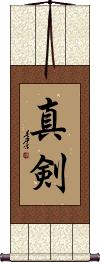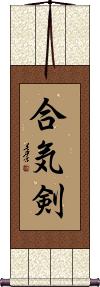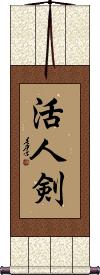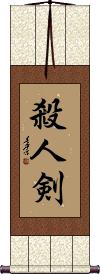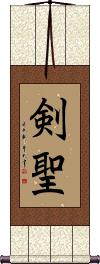Many custom options...
And formats...

剣 in Chinese / Japanese...
Buy an 剣 calligraphy wall scroll here!
Personalize your custom “剣” project by clicking the button next to your favorite “剣” title below...
1. Sword
4. Aiki-Ken
8. Kendo / The Way of the Sword
9. Sword Saint
10. Shinken Shobu
11. Ki Ken-Tai Icchi
Sword
剱 is the modern Japanese way to write sword.
This Kanji character comes from original Chinese. This form would also be understood in Chinese (there are often several ways to write the same character) but I suggest this one only if your audience is Japanese (because they've settled on a slightly different form as the standard in China).
In Japanese, this character also means saber/sabre, blade, bayonet, stinger, and clock hand (clock hands are the “swords” of the clock).
Kenjutsu / Kenjitsu
In Japanese, the modern definition, using simple terms, 剣術 is “A martial art involving swords” or “The art of the sword.”
However, in Chinese, this is the word for fencing (as in the Olympic sport).
I will suppose that you want this for the Japanese definition, which comes from skills and techniques developed in the 15th century. At that time, Kenjutsu (or swordsmanship) was a strictly military art taught to Samurai and Bushi (soldiers). The fact that swords are rarely used in military battles anymore, and with the pacification of Japan after WWII, Kenjutsu is strictly a ceremonial practice often studied as a form of martial art (more for the discipline aspect rather than practical purpose).
Language note: The Korean definition is close to the Japanese version described above. However, it should be noted that this can mean “fencing” depending on the context in Japanese, Chinese, and Korean.
![]()
![]() Character variation notes: There are slight variations possible with the second character. Either way is correct and understood by both Japanese and Chinese folks.
Character variation notes: There are slight variations possible with the second character. Either way is correct and understood by both Japanese and Chinese folks.
Since there are about 5 common ways to write the sword character, if you are particular about which version you want, please note that in the “special instructions” when you place your order.
Romanization note: This term is often Romanized as Kenjitsu; however, following the rules of Japanese Romaji, it should be Kenjutsu.
Intense / Serious
Aiki-Ken
Life-Saving Sword
Sword of Death
殺人剣 is a Japanese title for “Death Sword,” “Life Taking Sword,” or “satsujinken.”
This is the opposite of katsujinken or the “life-saving sword.” This title is not as commonly used in Japanese but pairs well when hung with katsujinken.
The first two Kanji are a word that translates as homicide, murder or kill (a person). 殺人剣 is specifically to kill a person (as the second character means person or human) as opposed to an animal, etc.
The last Kanji is the Japanese variant of the originally-Chinese character for a sword.
Throwing Star
Kendo / The Way of the Sword
Often associated with Kenjutsu, 剱道/劍道 means “The way of the sword” in Japanese (and Korean with an alternate form of the first character).
This is also the term used for swordsmanship and even fencing in Japanese and Korean, depending on context.
Note: These same characters are also used separately in Chinese, but this exact combination yields a common title in Japanese only (perhaps someone who is really into swords would use this in China).
Note: There is more than one way to write the “sword” character (shown above is the Japanese version - if you want the Korean version, please let me know when you place your order).
Sword Saint
剣聖 can be translated as “Sword Saint,” “God of the Sword,” or “Saint of the Sword.” This is an ancient Japanese title bestowed on a master with the greatest of skills in swordsmanship.
Keep in mind that this is an antiquated term. It will only be understood in the context of martial arts. The pronunciation “kensei” also applies to other words like “constitutional government” and power (these words have different kanji and are completely unrelated).
Notes: This is sometimes Romanized as “kensei,” “ken sei,” and incorrectly as “Kensai.”
Chinese Note: This title is pronounceable in Chinese but seldom, if ever, used in Chinese. Also, the first character is an alternate character form for a sword, currently only used in Japan.
Shinken Shobu
Death Match
In modern Japanese, 真剣勝負 means to take something very seriously.
The literal and historical meaning is “real sword battle.” In old times, a Samurai apprentice would practice with a wooden practice sword. Once trained and qualified, they would wield a real steel sword made for battle and killing. They were ready for a “death match” or Shinken Shobu.
真剣 is an adjective that has come to mean serious/earnest. The literal translation is “real sword.”
勝負 in the simplest terms, means match, contest, game, or bout. Depending on the context, it could also mean victory or defeat, winning and losing, or the outcome of a battle.
There is a suggestion in Shinken Shobu that you train with serious and real intent, as we should train with the same fervor and dedication as if the battle was real. “Train as we fight.”
Ki Ken-Tai Icchi
気剣体一致 is the title Ki Ken-Tai Icchi.
気 = energy, 剣 = sword, 体 = body, 一致 = synchronization/unity. So, “energy, sword, and body in unison” would be one way to translate this. Sometimes written with the possessive article, の, making it 気剣体の一致 or “Ki Ken-Tai no Icchi.” Let me know in the special instructions if you want that の character added by the calligrapher.
Energy Sword Body in Concert
Spirit, Sword & Body as One
气剑体一致 often gets translated as “Mind Sword Body,” or “Spirit, Sword, and Body as One.” But I think these translations don't tell you enough about what this is really saying.
In this context, 気, which is the modern Japanese version of 氣, means spiritual and unseen energy or “life energy.” In some cases, 気 can be translated as spirit, feeling, or nature. If defined as the mind, it's more about the invisible or intangible parts of one's mind (or soul).
剣 is the Japanese version of 劍 meaning sword.
体 is the modern Japanese version of 體 meaning body.
The Kanji 一 means one, and in this case, suggests “all in one.”
The Kanji 到 means to send, deliver, or convey. But together, 一到 suggests all these things in agreement, union cooperation, or in concert.
Note: Arguments exist as to whether this should be romanized as Kikentaiitchi, Kikentaiicchi, or kikentaiichi. Technically, if you drop the last character, you get 気剣体一 and kikentaiichi (ki ken tai ichi), which is also a valid phrase.
Not the results for 剣 that you were looking for?
Below are some entries from our dictionary that may match your 剣 search...
| Characters If shown, 2nd row is Simp. Chinese |
Pronunciation Romanization |
Simple Dictionary Definition |
剣 see styles |
jiàn jian4 chien mayaka まやか |
More info & calligraphy: Swordsword (originally esp. a doubled-edged sword); sabre; saber; blade; (1) sword (originally esp. a doubled-edged sword); sabre; saber; blade; (2) bayonet; (3) swordsmanship; (4) stinger; ovipositor; dart; (female given name) Mayaka |
剣術 see styles |
kenjutsu けんじゅつ |
More info & calligraphy: Kenjutsu / Kenjitsu |
剣道 see styles |
kendou / kendo けんどう |
More info & calligraphy: Kendo / The Way of the Sword |
真剣 see styles |
shinken しんけん |
More info & calligraphy: Intense / Serious |
手裏剣 see styles |
shuriken しゅりけん |
More info & calligraphy: Throwing Star |
殺人剣 see styles |
satsujinken さつじんけん |
More info & calligraphy: Sword of Death |
活人剣 see styles |
katsujinken; katsuninken かつじんけん; かつにんけん |
More info & calligraphy: Life-Saving Sword |
真剣勝負 see styles |
shinkenshoubu / shinkenshobu しんけんしょうぶ |
More info & calligraphy: Shinken Shobu |
上剣 see styles |
kamitsurugi かみつるぎ |
(place-name) Kamitsurugi |
下剣 see styles |
shimotsurugi しもつるぎ |
(place-name) Shimotsurugi |
中剣 see styles |
nakatsurugi なかつるぎ |
(place-name) Nakatsurugi |
佩剣 see styles |
haiken はいけん |
(noun/participle) wearing a sword |
俊剣 see styles |
toshihaya としはや |
(personal name) Toshihaya |
八剣 see styles |
yatsurugi やつるぎ |
(place-name, surname) Yatsurugi |
刀剣 see styles |
touken / token とうけん |
sword; dagger; knife; bayonet |
利剣 see styles |
riken りけん |
sharp sword |
剣一 see styles |
kenichi けんいち |
(given name) Ken'ichi |
剣二 see styles |
kenji けんじ |
(given name) Kenji |
剣人 see styles |
kento けんと |
(personal name) Kento |
剣介 see styles |
kensuke けんすけ |
(personal name) Kensuke |
剣允 see styles |
hayamasa はやまさ |
(personal name) Hayamasa |
剣先 see styles |
kensaki けんさき |
point of a sword; (place-name) Kenzaki |
剣光 see styles |
kenkou / kenko けんこう |
light emanating from a sword; shimmering of a sword; (personal name) Kenkou |
剣刀 see styles |
hayato はやと |
(female given name) Hayato |
剣劇 see styles |
kengeki けんげき |
sword play; samurai drama |
剣匠 see styles |
kenshou / kensho けんしょう |
(See 刀鍛冶・かたなかじ) swordsmith |
剣友 see styles |
kenyuu / kenyu けんゆう |
(male given name) Ken'yū |
剣司 see styles |
kenji けんじ |
(personal name) Kenji |
剣吉 see styles |
kenyoshi けんよし |
(place-name, surname) Ken'yoshi |
剣名 see styles |
tsurugina つるぎな |
(surname) Tsurugina |
Click here for more 剣 results from our dictionary
The following table may be helpful for those studying Chinese or Japanese...
| Title | Characters | Romaji (Romanized Japanese) | Various forms of Romanized Chinese | |
| Sword | 剱 剣 | ken | jiàn / jian4 / jian | chien |
| Kenjutsu Kenjitsu | 剣術 剑术 | kenjutsu | jiàn shù / jian4 shu4 / jian shu / jianshu | chien shu / chienshu |
| Intense Serious | 真剣 | shin ken / shinken | ||
| Aiki-Ken | 合気剣 | ai ki ken / aikiken | ||
| Life-Saving Sword | 活人剣 | katsu jin ken katsujinken | ||
| Sword of Death | 殺人剣 杀人剣 | satsu jin ken satsujinken | ||
| Throwing Star | 手裏剣 | shu ri ken / shuriken | ||
| Kendo The Way of the Sword | 剱道 / 劍道 剣道 | kendou / kendo | jiàn dào / jian4 dao4 / jian dao / jiandao | chien tao / chientao |
| Sword Saint | 剣聖 / 剣聖 剣圣 | kensei | jiàn shèng jian4 sheng4 jian sheng jiansheng | chien sheng chiensheng |
| Shinken Shobu | 真剣勝負 | shinken shoubu shinkenshoubu shinken shobu | ||
| Ki Ken-Tai Icchi | 気剣体一致 | ki ken tai icchi kikentaiicchi ki ken tai ichi | ||
| Energy Sword Body in Concert | 気剣体一致 / 氣劍體一致 气剑体一致 | ki ken tai icchi kikentaiicchi ki ken tai ichi | ||
| In some entries above you will see that characters have different versions above and below a line. In these cases, the characters above the line are Traditional Chinese, while the ones below are Simplified Chinese. | ||||
Successful Chinese Character and Japanese Kanji calligraphy searches within the last few hours...


